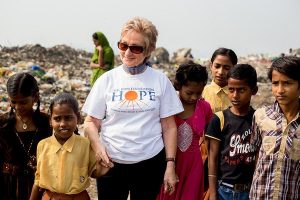
While India has been enjoying unprecedented economic success and, has slowly but surely been progressing in terms of social awareness and responsibility as a result, it still has a long way to go in becoming a more responsive society. Because of that, The Hope Foundation founder and director Maureen Forrest [pictured above] launched the organization to try and rectify the depredation and debilitating effects of crushing poverty.
Set up in 1999 to raise funds for one girl’s home, The Hope Foundation evolved into an organization which works with some of the most disadvantaged children in the world today. In the past decade, The Foundation’s efforts have been critical in securing the rights for the underprivileged sections of Indian society, especially with the street and slum children of Kolkata (formerly Calcutta), India. Now a registered Irish charity with offices in Ireland, India, the UK, Germany and the USA, the organization is beginning to make its presence known in New York City with “The Taste of Hope,” their annual NY fund-raiser taking place this February 27th at the American Irish Historical Society (991 5th Avenue in Manhattan).
 From founder Forrest’s humble West Cork beginnings, she and her organization touched the lives and hearts of many, both in Ireland and in countries across the globe that benefit from her hard work. This selflessness has allowed thousands of children to have a chance at a future they otherwise wouldn’t have had. In order to reinforce this altruism, Forrest performs her role as the director on a completely voluntary basis, receiving no salary for her work, with her satisfaction coming from the impact of the Foundation’s aid has had on the lives of so many.
From founder Forrest’s humble West Cork beginnings, she and her organization touched the lives and hearts of many, both in Ireland and in countries across the globe that benefit from her hard work. This selflessness has allowed thousands of children to have a chance at a future they otherwise wouldn’t have had. In order to reinforce this altruism, Forrest performs her role as the director on a completely voluntary basis, receiving no salary for her work, with her satisfaction coming from the impact of the Foundation’s aid has had on the lives of so many.
In a conversation held recently at Gossip, Maureen reflected on how the Foundation came to be. “I was working with Aer Lingus in Shannon. Having lived in Limerick before I met my husband, we settled in Mogeely in West Cork where we raised a family. I remember the Medical Missionary of Mary coming to talk to us at school about work overseas and their stories stayed with me. But, I couldn’t have predicted the outcome that would unfold once I visited the poverty-stricken countries of Swaziland and Mozambique in 1980.
“My own humanitarian journey began after I first volunteered in war torn Somalia, working in a center for 2000 children. During the early ’90s, I also traveled to Rwanda and volunteered in a place flooded with refugees from the genocide, and prayed alongside the grim sight of mass graves. It was harrowing; I felt compelled to do something to help. All of us have been given talents and we have a choice on how to use them. I chose this life and have never regretted my commitment to the children with whom I work. As Ralph Emerson once put it, ‘to know that even one life has breathed easier because you have lived, this is to have succeeded.'”
Such an experience eventually led Forrest to her first visit to Kolkata which was like nothing she had experienced before. “I wasn’t prepared for the horror of Kolkata with its open sewers and the number of children on the streets. The gangs of children were trying to protect each other at night. I came across kids who were hiding razor blades under their tongues; they were living in constant fear. The children we started with in 1999 are now fully sustainable and able to take their place in society. Still today, we find children abandoned – like Riya, a severely disabled girl who was found in a bag under a seat on a train hours from death; she is now in the full-time care of the Foundation.”
Slums are something that is very hard to imagine unless you have seen them first hand. So what was the reality of slum life in countries such as Kolkata? The diminutive Forrest had this to add. “The reality is that every day is a struggle to merely survive. What really haunts me are the children involved in child labor or those who are trafficked into prostitution and knowing that they have never known love and have missed out on their childhoods. I often wonder about their pain and anguish at night, not even having someone to give them a comforting hug.”
So that begs the question: what made her decide to set up this foundation? “This life-altering experience in Kolkata inspired a huge, life-altering change. So deeply moved by the hopelessness and exploitation of children there, I decided to make a lifelong commitment to the poor. My initial goal was to run a home for 25 children and raise 25,000 euro a year to run. Now, the foundation runs over 60 projects including 12 protection homes and a hospital.
“I remember meeting a little girl in our hospital who was tortured and had to jump out of a building to escape. When she arrived, her body was totally broken and battered. With these cases, it’s so difficult to restore their lives to a semblance of normality. We work to aid this rehabilitation with counseling, nurturing and protection but it’s a long and slow process. The positive side of our work is that we are now helping many more children escape from these horrors and giving them a pathway out of poverty and towards a brighter and sustainable future. Some of these children have gone on to colleges and universities.”
Inevitably, setting up a foundation such as Hope involves the many difficulties of funding or spreading the word. Forrest reflected on the process of setting it all up. “Of course, it’s always difficult to start an organization — I had plans to fund one home for 25,000 Pounds at the time which I thought was achievable, then as awareness was created through the media, I started to realize the generosity of the Irish people so the foundation just grew. It was these people who dictated its growth and how many children we could help by identifying with their plight.”
And the mission of the Hope Foundation naturally followed. “We work towards this goal every day of creating a world where it should never hurt to be a child. Since our beginnings in 1999, 2.2 million individuals now have access to healthcare services through our interventions in 35 slum communities. Over 65,000 children have received educational support; many are first generation learners. In addition, more than 7000 children have been protected from abuse and neglect and another 6000 or so kids and young women are in our skill enhancement and empowerment program. I never regard the Foundation as a charity but as an organization that invests in the sustainability of human life, affording people with necessary skills and an opportunity to become self sufficient.”
Over the years, there have been so many positive and amazing stories of change. “My role has taken me on an extraordinary life journey and I’ve been blessed to have crossed paths with some of the most wonderful people in the world. When I saw some of the first children we helped move on through education and then in turn, help others to do the same — that was a special moment for me. Take Parveen, who grew up through Hope, and is now a trainer in our life skills tailoring unit; he helps others out of poverty through education.
What inspires her now to keep going in this work when things get tough? “One of the stories that will always stay with me was when I was in Somalia and a little baby died in my arms for no other reason than us not having access to a bottle to feed it. In Rwanda, I also bore witness to the burial of thousands of innocent people in mass graves during the horrific genocide. The hopelessness in the early years of working in Kolkata will always stay with me, with so many living on the streets and being abused – sexually and physically – and robbed of their childhoods.
“My visits to Kolkata every year reinvigorate my spirit to continue with the work because I know I can leave that slum and go back to my comfortable home but the people and children with whom we work do not have that choice, they live in abject poverty.”
A quote by Gandhi can best sum up the success of the foundation. “A small body of determined spirits fired by an unquenchable faith in their mission can alter the course of history.”
Acknowledged Forrest, “I believe that Hope is a family and that no man is an island; none of our success could have been achieved by one person. All the success of the foundation can be attributed to the help of such loyal staff and supporters in Ireland and beyond. I firmly believe that is the reason that we have helped to reach out to so many thousands of little children.”
For more information go to: https://hopefoundationusa.com or mary@hopefoundationusa.com
The Hope Foundation USA
New York, NY
516-467-6030
